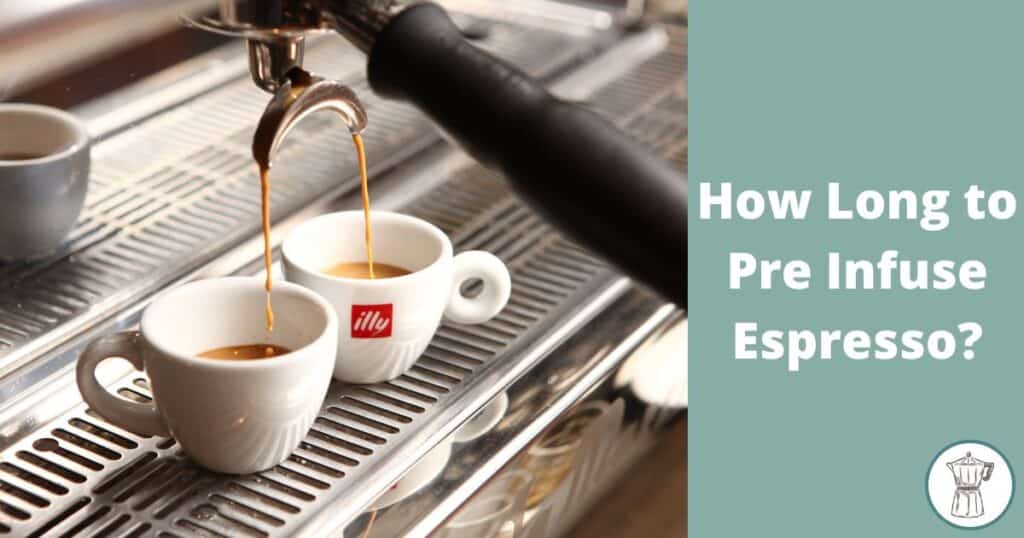Did you ever wonder how long to pre-infuse espresso? This is a common question among all of us who just bought our first espresso machine and we’re trying to get the hang of it. Stick around, in this article, we spill the beans on how long to pre-infuse espresso and a bunch of other top tricks that will make your coffee taste better. Let’s dive right into it.
Key takeaways:
- The brewing-espresso stages
- The ideal pressure for brewing espresso
- The pressure a Moka pot produces to make espresso
The 3 stages of brewing espresso
Almost all espresso machines use the same process to brew espresso. This is a 3-step process:
- Pre-brewing
- Pre-infusion
- Pressure manipulation
Let’s talk about every 1 of them in depth.
1. Pre-brewing
Pre-brewing is a crucial step in the process of making great espresso.
In this stage, a small amount of water runs from the tank to the brew chamber and wets the top part of the coffee puck. This softens the coffee grinds and helps to extract all the flavours and aromas from them for a richer cup of coffee. In other words, this is the stage where the espresso machine prepares itself for brewing.
2. Pre-infusion
This is the stage where a constant stream of water at a low pressure (about 3 bars) is introduced until the moment the pump starts the pressuring so the machine pulls an espresso shot. The aim of the pre-infusion stage is to fully wet the puck and get it ready for extracting coffee in liquid form. Pre-infusion can make your coffee taste great or just spoil the taste of it if it’s done wrong. For this reason, I recommend checking your manual book with instructions to see what your machine’s manufacturer suggests. As a rule of thumb between 2 and 8 seconds is the best time for the majority of espresso machines.
3. Pressure manipulation
This is the last stage and since the puck is fully wet, pressure is applied (the ideal pressure should be between 7 and 11 Bars) and this is how an espresso machine brews espresso.
This is what a coffee lover has to share about espresso preinfusion:
Preinfusion is useful for gently saturating the puck. In events where puck prep is uneven (puck density is uneven), preinfusion helps “even out” the puck reducing channeling. If you have perfect puck prep (I don’t), preinfusion won’t matter much. there are ways to work around uneven puck prep such as coarser grinding and WDT and other distribution tools and PI is one of the tools for this. I know you’re looking for an electric machine but if you don’t drink milk drinks that often try checking out a flair or a cafelat Robot.
– Kofimornings
That’s another opinion on preinfusion of espresso:
You don’t need variable preinfusion and extraction profiling to be able to enjoy espresso with fruity notes. There are many great blends and SO roasts out there in the medium and darker range that can be extracted well enough on a typical E61 box or similar machine. When you’ve found ones that work well for you, take note of your perception of roast level (I’ve found roasters’ descriptions to be more about marketing than actual level), which areas the beans come from, and, if evident, if the beans are “natural” or “washed”. Natural processing refers to the beans being dried with the fruit still around them for some period of time. It typically adds “fruity” notes from the fermentation. Washed beans are just as “natural” in the wholesomeness sense. It is that the beans have been removed from fruit before they are dried, so that they have more of their own flavors, which can be more subtle than a natural-processed coffee. Neither is better than the other. Some have preferences one way or another, which can vary with the origin and cultivar of the bean itself.
– Jeff
How long should the pressure manipulations last?
This needs a little bit of experimentation. If you ask different baristas, the odds are you’ll get different kinds of answers. Perhaps, it also has to do with the brand of the espresso machine itself. So, in any case, you really need to find what works best for you. In many machines including La Marzocco the pressure manipulation is directly related to the paddle. The further the paddle is moved the higher the pressure. It’s worth mentioning that it’s no good brewing espresso at high pressure; it spoils the coffee. If your Breville has low pressure learn how to fix it.
What you should know about the pressure (bars)?
The pressure measured in bars is directly related to Earth’s standard atmospheric pressure.
For example, when you see that a machine can reach up to 9 bars of pressure it means that this pressure is 9 times higher than the one of Earth’s normal pressure. As we already mentioned 7-11 bars are typically ideal to pull a delicious espresso. Higher than that means that you’ll be able to brew espresso faster but it might lack taste and aroma. If it’s lower than the ideal, it usually means that your machine won’t extract all the flavours and aromas from the coffee grinds, so you won’t make the most of your coffee.
After you’re done with your coffee it’s vital to clean your machine and remove the espresso puck from the portafilter to remove all the used coffee.
How long does Preinfusion Barista Express take?
The Barista Express is built in a way that the pump works at a lower pressure than a typical espresso machine. So, the preinfusion in this machine lasts 10 seconds. You can use it with the default feature or simply modify the preinfusion manually and really find what works best for you.
Moka pot
Does the 3-stage apply to espresso made with a Moka pot?
Things are slightly different with a Moka pot since the pressure it applies is only 1.5 Bars and in order to pull an espresso shot takes longer than the one you make with an espresso machine. But this isn’t necessarily a bad thing. As a coffee lover, I can wait a couple of minutes more to drink a delicious espresso. The fact that the process takes longer it means that the coffee is prepared the right way and the flavours come out of the coffee grinds.
Electric coffee machine
An electric machine is a machine that works in a very similar way to a Moka pot, but the only difference is that you don’t need to put it on a stove to brew coffee. It has a heater attached that heats the coffee itself
Similar to the Moka pot an electric coffee machine uses the same pressure (1.5 Bars) to brew coffee. As mentioned before this way espresso is done slower but it doesn’t lack taste or aroma.
The table summarises the pressure in bars per coffee tool:
| Machine/tool: | Pressure in bars: |
| Espresso machine | 7-11 |
| Moka pot | 1.5 |
| Electric coffee machine | 1.5 |
Let’s wrap it up
Are you ready to pre-infuse espresso now? I know, when I first realised what the right way to do it was, I thought I was a top barista (I’m not). I hope you learned a thing or 2 from this article – you have no excuse now for making bitter espresso, it should be as good as the one you get at a hipster cafe (only joking).
See you around.

- How to Remove Coffee Stains From Countertop The Easy Way - December 21, 2023
- Can You Reuse Coffee Grounds in French Press? Truth Inside - December 12, 2023
- Can Expired Coffee Creamer Make You Sick? 3 Ways to Find Out - December 9, 2023
